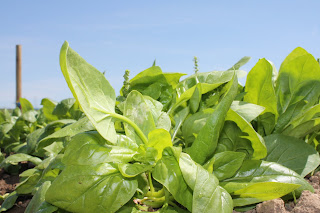


The rain and sunshine is working wonders at the allotment, everything is springing to life. The potatoes, broadbeans and onions are showing renewed growth and the new seedlings such as the courgettes, chicory and beetroot are taking hold.
It is important to give vegetables extra nutrients and making your own organic fertiliser could not be easier. This is especially the case when the same patch of soil is in constant use, such as an allotment, and vegetable growing in particular uses up a lot of nutrients from the soil. So as with farming, intensive successive growing will require you to replenish what is taken out in order to maximise the crop from your patch.
There are a plethora of ways to nourish, condition and improve your soil. Regularly adding compost definitely helps, as the soil benefits from the nutrition and structure to aid water drainage. However compost on it's own may not be enough - a regular 'top up' with an organic fertiliser is vital if you want your vegetables to flourish.
You can make your own organic fertiliser easily at home. The ingredients can be sourced directly from the garden or allotment. Jenny Young of Castlefarm explains that one of the simplest yet effective organic fertilisers you can make is from nettles. A liquid nettle feed are a great source of nitrogen, perfect for plants growing above ground. Nettle feed has also been attributed as a fantastic feed for tomatoes.
To make your liquid nettle fertiliser, you'll need lots of nettles, water and a large storage butt or bucket. Firstly, you'll need to collect up your nettles - as many as you can find! If possible, opt for younger, more tender stems. Once you have collected your nettles, you can either chop them up with secateurs, crush them (wearing thick garden gloves, of course!), or shred them through a lawnmower or garden shredder.
The crushed or shredded nettles can then be put in the container. You can weigh the pile of nettles down with a stone or brick, before adding water. You should add enough water to just about cover the pile of nettles.
You'll then need to leave the 'brew' for around 20-30 days. During this time, the mixture starts to smell somewhat, so you might want to site it in a secluded corner of your garden or allotment! The brew will also become like a rich feed concentrate, so once it's ready to use, you'll need to dilute it with water to a ration of around 1:10 before feeding it to your plants.
If you have any leftover feed, this can always be added to your compost heap or bin over winter when the nettle-growing season finishes.
Happy feeding!






















